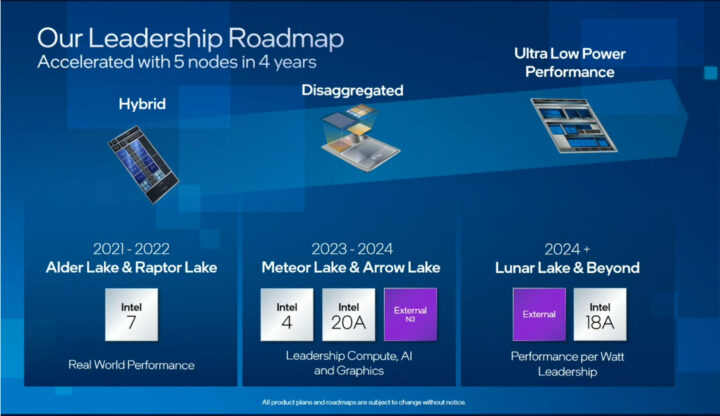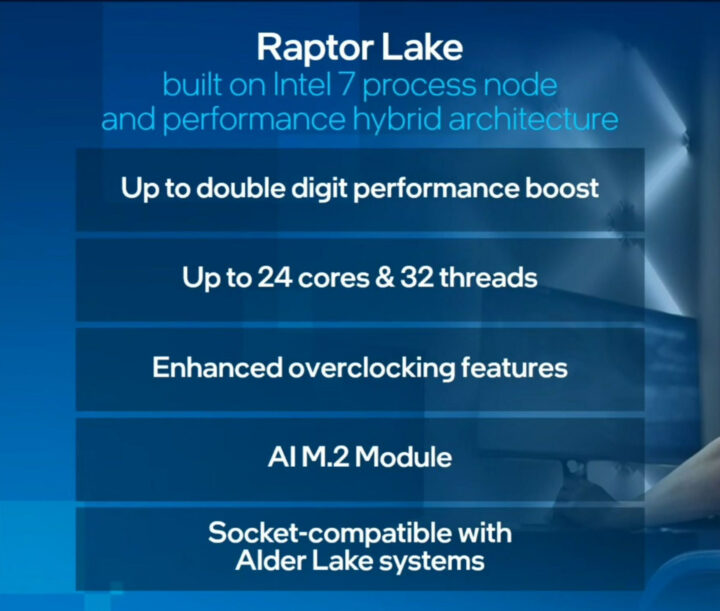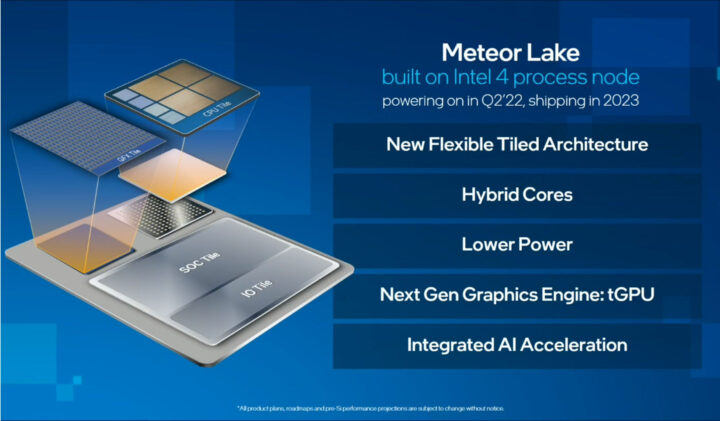Apple-designed Arm processors have shown it’s possible to get high-performance at relatively low power, and this has left competitors behind in that regard. But Intel aims to rectify that with the goal of becoming the “performance per watt leader” by 2024 with the new Lunar Lake processors manufactured with Intel 18A process.
Intel also provided some details about families following Alder Lake processors with Raptor Lake expected later this year, Meteor Lake and Arrow Lake based on Intel 4 and 20A processes in 2023-2024 2022, and Lunar Lake expected in 2024+.
Let’s have a look at what we know so far for each family.
Intel Raptor Lake
The Raptor Lake processors will rely on the same “Intel 7” process as Alder Lake processors, offer up to double-digit performance boost (translation: up to around 10% in specific workloads), up to 24 cores and 32-threads, better overclocking, support for AI M.2 modules (not quite sure why it’s news), and socket-compatibility with Alder Lake SoCs.
The dissymmetry between the number of cores and threads is because we’re dealing with hybrid processors, and only the Performance cores will support multi-threading. In that particular case, it means 8 Performance cores with 16 Efficiency cores for a total of 24 cores and 32 threads. Raptor Lake family is expected to launch in H2 2022.
Meteor Lake
There are few details for the Meteor Lake, but the “New Flexible Tiled Architecture” looks a lot like the “Open Chiplet Platform” announced a few weeks ago together with a one billion dollars investment in foundry technology innovation. Hybrid cores are here to stay, and the main highlights should be the new tGPU graphics engine and integrated AI accelerator. The first samples should be ready in Q2 2022, and shipping is scheduled in 2023.
There’s no detailed slide that I could find for Arrow Lake. But the roadmap above shows Intel 4 and Intel 20A processes for Meteor Lake and Arrow Lake, so Arrow Lake may just be the switch to Intel 20A with few architecture changes.
Lunar Lake
The new Lunar Lake processors will target ultra low power performance with the Intel 18A process. Intel claims they’ll reach performance per watt leadership by 2024, but we’ll have to wait and see, and Intel initially told us the 18A process would only be ready around 2025, and competitors will not stay idle in the next 2 to 3 years.
All slides from the Intel Investor Meeting 2022 via Ian Cutress. Thanks to NewTips for the link.

Jean-Luc started CNX Software in 2010 as a part-time endeavor, before quitting his job as a software engineering manager, and starting to write daily news, and reviews full time later in 2011.
Support CNX Software! Donate via cryptocurrencies, become a Patron on Patreon, or purchase goods on Amazon or Aliexpress








In an amazing coincidence, AMD aims to be the performance per watt leader in 2024.
So what’s the deal with the “AI M.2 module” anyway? Why does the CPU need to support it?
About the AI module. Perhaps it will be supported by the coming “modular system design”, where CPU features may be soft-locked? An AI feature could theoretically be backed by separate hardware. The module would, likely, not be visible by the system.
Some statistics on green500 already show that AMD beat ARM & Sunway on power/watt, but this is probably mainly due to a huge number of core in one package. ARM should have a better scale of efficiency as soon as they build as much core/package, with their own processors architecture. RISC-V core should beat them all at the end anyway :).
Yeahhhh… sure
So… 2-3 years before Intel re-enters the sub-laptop/mobile market fully again.
Killing Broxton was a big mistake. Would have bridged the gap much better with a long life chip that could have gotten cheap and plentiful.
History shows there is a very clear proven path to better CPU and GPU, but I have no interest in helping the scalpers Intel.
I think both will lose from ARM APUs in 2024 if someone do what Apple achieved with M1.
How? Windows on ARM … ?
Why windows? Linux! 🙂
… is 2022 the year of Linux on the desktop?
Nope, and I don’t care. But if you want something with ARM, extensive applications, linux is your best bet for now.
By the time Intel gets there, ARM will be 3 more steps ahead.
Easier said than done.
Clown Pat Gelsi copies AMD and Lisa Su’s :leadership: word in all context now?
Intel come up with something else. Leadership is at AMD while you were milking the world is quad core for a decade!
Thanks to that, They’re beaten hard by AMD.
I do not understand amd/intel hate in this discussion. First of all, what Apple did with M1 is engineering marvel in some sense, but do not forget it’s properties: (1) the best process node. AMD is 1 level back and Intel was 2 levels back at the time! (2) apple chosen really wider core and modest max frequency. Neither AMD nor Intel supports that. I guess thanks to both props they are perf/watt leader now, but this is nothing which may change to either side in the future.
Some folks here claims ARM will be better and some RISC-V will kill them all, but honestly this is so 80s or early 90s thinking. We’re at the perfromance level and so huge number of transistors that ISA as it is is completely irrelevant as any processor of this performance and size needs to be out-of-order completely with a huge number of internal registers and its own RISC ISA inside to which arch ISA is translated by CPU front-end. Intel if like may choose to implement RISC-V or ARM front-end on top of their E or P cores-backends, change UEFI and try to occupy different ISA domain this way. Ditto for AMD of course.
>I do not understand amd/intel hate in this discussion.
Bizzare tribalism – RISC good, CISC bad. RISC has blast processing, CISC is that whack 8 bit stuff isn’t it?
Rooting for the underdog – ARM is still treated as if it’s still a plucky little company that made some computers 80s/90s kids in the UK might have used at school instead of the multi-billion dollar company it is.
Imagined historical grievances – Intel, Microsoft, IBM etc are all constantly running over kittens to retain their status as evil corps. At some point in time they ran over your kitten or the kitten of someone you know.
Pretty well summarized 😉